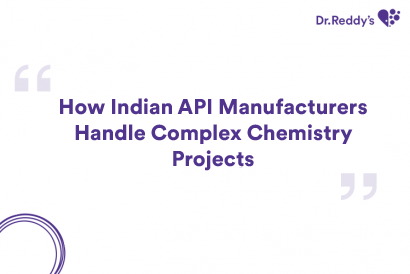Understanding Nitrosamines and GTI Issues in APIs: A Comprehensive Overview with Dr. Reddy's Perspective
In recent years, Dr. Reddy's Laboratories, a prominent player in the global pharmaceutical industry, has been navigating challenges related to nitrosamines in active pharmaceutical ingredients (APIs). Nitrosamines are a class of potentially carcinogenic compounds that can inadvertently form during the synthesis or storage of pharmaceutical products, posing significant regulatory and safety concerns.
What are Nitrosamines?
Nitrosamines are organic compounds characterized by the nitroso group (NO) attached to an amine- containing structure. They are classified as genotoxic impurities (GTIs), capable of causing DNA damage and increasing the risk of cancer in humans. Due to their potential health risks, regulatory agencies worldwide have imposed strict limits and guidelines for their presence in pharmaceuticals.
Sources of Nitrosamines in APIs
The presence of nitrosamines in APIs can arise from various sources:
Raw Materials Contamination: Contaminated raw materials containing amines or amine precursors can introduce nitrosamines during the manufacturing process.
Chemical Reactions: Certain synthetic processes involving amines and nitrosating agents can inadvertently lead to the formation of nitrosamines.
Packaging and Storage: Interaction of APIs with packaging materials or specific storage conditions can potentially induce nitrosamine formation over time.
Regulatory Response and Guidelines
In response to the detection of nitrosamines in pharmaceutical products, regulatory bodies such as the FDA and EMA have issued stringent guidelines and directives:
Risk Assessment: Manufacturers like Dr. Reddy's Laboratories are required to conduct thorough risk assessments to identify potential sources of nitrosamines in their manufacturing processes.
Analytical Methods: Dr. Reddy's Laboratories employs advanced analytical techniques, including LC-MS/MS, for sensitive detection and quantification of nitrosamines at trace levels, ensuring compliance with regulatory limits.
Control Strategies: Robust control strategies are implemented throughout the manufacturing process to prevent nitrosamine formation and ensure the integrity of APIs and finished pharmaceutical products.
Collaboration and Compliance: Dr. Reddy's Laboratories collaborates closely with suppliers to ensure the quality and purity of raw materials, adhering to stringent quality standards and regulatory requirements.
Addressing Nitrosamines and GTI Issues
To effectively address nitrosamine and GTI issues in APIs, Dr. Reddy's Laboratories employs a comprehensive approach:
Quality Control: Dr. Reddy's Laboratories integrates rigorous quality control measures into its manufacturing processes, from raw material sourcing through to finished product testing.
Innovation and Research: Continuous innovation and research efforts are undertaken to develop and implement advanced technologies and methodologies for nitrosamine detection and mitigation.
Regulatory Adherence: Dr. Reddy's Laboratories maintains a proactive stance in complying with evolving regulatory guidelines, ensuring timely reporting and corrective actions if nitrosamines exceed permissible limits.
Advanced Analytical Capabilities: Dr. Reddy's has invested in state-of-the-art analytical equipment and methodologies to detect and quantify nitrosamines and GTIs at trace levels.
Stringent Raw Material Testing: The company implements rigorous testing protocols for all incoming raw materials to identify and eliminate potential sources of contamination.
In-Process Control: Continuous monitoring of manufacturing processes helps to prevent the formation of nitrosamines and GTIs.
Finished Product Testing: Every batch of API and finished product undergoes comprehensive testing to ensure compliance with regulatory limits.
Process Optimization:
Continuous Improvement: Dr. Reddy's employs a culture of continuous improvement to optimize manufacturing processes and minimize the risk of contamination.
Alternative Synthesis Routes: The company explores alternative synthetic pathways to reduce the formation of nitrosamines and GTIs.
Solvent Selection: Careful selection of solvents to avoid those that can contribute to nitrosamine formation.
Supplier Management:
Supplier Qualification: Dr. Reddy's maintains stringent supplier qualification and auditing processes to ensure the quality of incoming materials.
Risk Assessment: Regular risk assessments are conducted to identify and mitigate potential risks from suppliers.
Regulatory Compliance:
Staying Updated: Dr. Reddy's closely monitors evolving regulatory guidelines on nitrosamines and GTIs.
Proactive Measures: The company implements proactive measures to exceed regulatory requirements.
Conclusion
Dr. Reddy's Laboratories remains committed to ensuring the safety and efficacy of its pharmaceutical products amidst the challenges posed by nitrosamines. By leveraging its expertise in pharmaceutical manufacturing, stringent quality control measures, and collaborative partnerships with suppliers and regulatory bodies, Dr. Reddy's Laboratories continues to uphold its commitment to patient safety and regulatory compliance. Through these efforts, Dr. Reddy's Laboratories aims to mitigate the risk of nitrosamine contamination and maintain the highest standards of pharmaceutical excellence globally.
- Call us:
 +91 40 49002253
+91 40 49002253
Contact Us
请填写以下表格,我们会尽快与您联系.





